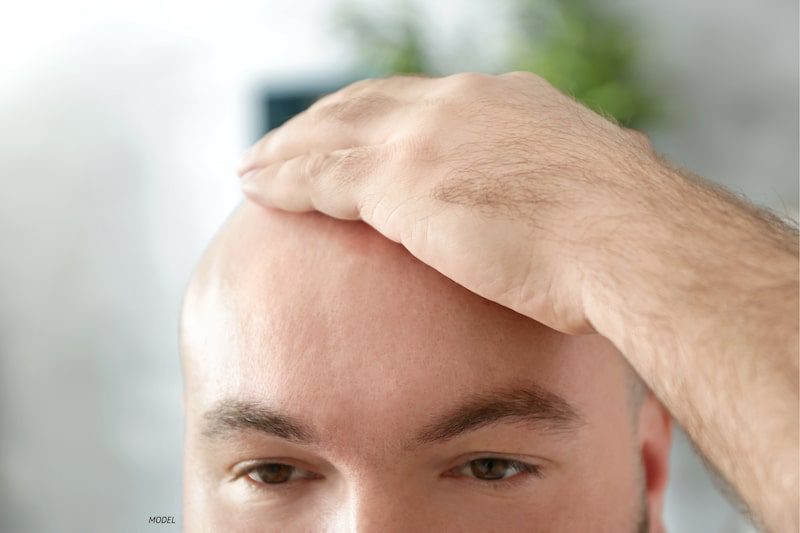Mohs Surgery, Reconstructive Plastic Surgery | The Office of Dr. Vincent Hung
Whenever a patient undergoes skin cancer removal surgery, many worries can go through their minds. One of the first is about the success of the operation and whether all of the cancer will be removed.
But after the cancer is taken care of, patients’ worries usually move onto the lasting results and impacts on the body, including future hair growth if the skin cancer was removed on the head.

Many worry that they will be forever bald after Mohs surgery, unable to grow hair. Unfortunately, whether you will have permanent hair loss issues after skin cancer removal on your head is not an easy Yes or No answer.
The extent of hair loss depends on the size of the surgery, its location, and the method used for closure. Removing skin affected by cancer, especially when larger areas are excised, may lead to permanent hair loss. However, in many cases, hair loss is only temporary.
The specific degree of hair loss and whether it is temporary or permanent would best be addressed by your surgeon. They can provide the best insight into what you can expect regarding hair regrowth and what techniques and aftercare measures you can take to minimize hair loss related to Mohs surgery.
What Is the Most Common Skin Cancer Removal Method?
Medical science has come a long way in successfully treating skin cancer. Mohs surgery is now the most common procedure for removing skin cancer while causing as little aesthetic harm as possible.
What Is Mohs Surgery on the Scalp?
Mohs surgery is designed to preserve tissue and minimize scarring by removing the cancerous area one layer at a time. Each tissue layer is examined to check for any remaining cancer cells, and the process is repeated until none remain.
When performed on the scalp, tissue preservation is critical. This procedure follows the standard Mohs surgery technique but focuses on scalp lesions and preventing excessive scars from developing.
What Are the Methods for Repairing the Scalp After Skin Cancer Removal?
During Mohs surgery, your surgeon will remove as much of the cancerous tissue and skin as needed to make sure that you are cancer-free. While it is best to let the skin of the scalp heal itself naturally, this is not always possible.
Sometimes, skin reconstruction is necessary, especially if the surgical site is large or deep. In this case, there are two methods for repairing the scalp. The extent of the cancerous area (size of the cancer) plays a part in which repair method is best for you.
Skin Flap
A skin flap is used if the follicles are removed, but the skin cancer is contained to a smaller area on the head. A skin flap uses the tissue surrounding the Mohs surgery site to cover the surgical area and heal.
This technique often allows for a smoother healing surface with similar coloration and texture and less chance of scar contracture (shrinking). This method preserves as many hair follicles as possible, though the pattern of the hair will change.
Skin Graft
While a skin flap offers many positives, especially in allowing hair to regrow, if the cancer excision site is large, a skin graft may be required.
While a skin flap maintains blood flow (since the skin is not removed from the body and reattached), a skin graft does not have continuous blood supply because it is skin that has been taken from another part of your body, moved, and attached to the Mohs surgery site.
A skin graft allows for more significant coverage and helps protect the surgical area; however, due to the nature of skin grafts, they usually do not allow hair to regrow in the reconstructed area without further treatment.
What Causes Hair Loss After Skin Cancer Removal?
Whether or not you will lose the ability to regrow hair after Mohs surgery depends on its effect on the hair follicles.
If only a few layers of cancerous tissue and skin were removed during surgery, the hair follicles can survive, and your hair should regrow without surgical intervention.
However, if the follicles were removed or directly affected during Mohs surgery (because the cancer was deeper and more layers of tissue and skin were removed), then the hair would not be able to grow back naturally, leading to baldness in that area.
It’s important to note that the nature of Mohs surgery is to preserve as much of the skin (including the hair follicles) as possible, but some cancers grow more deeply than others.
Is Losing My Hair After Mohs Surgery Like Alopecia?
Hair loss after Mohs surgery typically occurs due to the surgical removal of skin cancer and the subsequent closure of the wound. Alopecia, on the other hand, refers to various factors that cause hair loss, such as genetics, autoimmune issues, hormonal changes, or other health conditions.
Mohs surgery-related hair loss, in most cases, is localized to the area where the surgery was performed and is not related to the conditions associated with alopecia.
How Long Is Recovery After Mohs Surgery on the Scalp?
After Mohs surgery on the scalp, recovery timelines vary widely depending on the extent of the procedure and individual healing abilities. However, you can expect the following sequence of events:
1. Immediately Following Surgery
Right after Mohs surgery on the scalp, the wound might be covered with a bandage or dressing. Mild pain, tenderness, and swelling around the surgical area are expected during the initial days.
2. During the First Week
It’s normal to experience some discomfort, swelling, and possibly bruising for the first week after surgery. Stitches and other wound closure methods will dictate the care required. Patients are typically advised to keep the area clean, dry, and protected per the doctor’s instructions.
3. The Next Few Weeks
The scalp wound will gradually heal, and if non-dissolvable stitches or sutures were used, they will need to be removed.
4. Longer-Term Healing
Complete healing after Mohs surgery on the scalp can take several weeks to a few months, with the wound improving and scars fading over time.
5. Follow-Up Visits
You will be scheduled for follow-up appointments with your surgeon so they can monitor the healing progress and address any concerns about the surgical site.
Throughout the recovery period, following your doctor’s post-surgical instructions is crucial. This includes proper wound care, avoiding strenuous activities, protecting the area from direct sunlight, and directions to ensure optimal healing.
Want to Learn More?
Feel free to call 626-432-5032 to Dr. Hung in Pasadena, CA, if you have questions about skin cancer removal or how Mohs surgery will affect your hair growth. If his Newport Beach, California office is more convenient for you, he can be reached at 949-574-8292.
